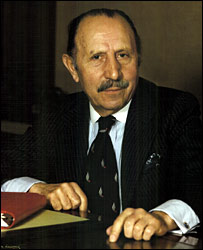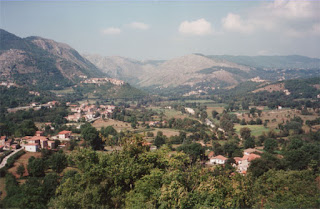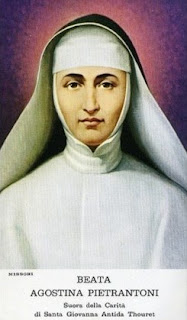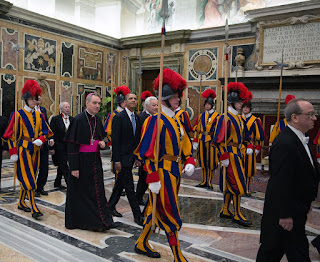Theologian who synthesised Aristotle’s ideas with principles of Christianity
 |
| A portrait of Saint Thomas Aquinas by the Italian artist Carlo Crivelli |
A Dominican friar who became a respected theologian and philosopher, D’Aquino was canonised in 1323, less than 50 years after his death.
He was responsible for two masterpieces of theology, Summa theologiae and Summa contra gentiles. The first sought to explain the Christian faith to students setting out to study theology, the second to explain the Christian faith and defend it in the face of hostile attacks.
As a poet, D'Aquino wrote some of the most beautiful hymns in the church’s liturgy, which are still sung today.
D’Aquino is recognised by the Roman Catholic Church as its foremost philosopher and theologian and he had a considerable influence on the development of Western thought and ideas. His commentaries on Scripture and on Aristotle are an important part of his legacy and he is still regarded as the model teacher for those studying for the priesthood.
D’Aquino was born in Roccasecca in the province of Frosinone in about 1225 in the castle owned by his father, who was count of Aquino.
He was placed in the nearby monastery of Monte Cassino when he was a young boy as a prospective monk. But after nine years in the monastery he was forced to return to his parents when the Holy Roman Emperor expelled all the monks for being too obedient to the Pope.
 |
| Fra Angelico's depiction of Thomas Aquinas with his Summa Theologiae in the Convent of San Marco in Florence |
He joined the Dominicans, which was a new religious order actively involved in preaching and teaching. His superiors immediately sent him to Paris pursue his studies.
But on the way there he was abducted on his parents’ orders because they did not want him to continue with the Dominicans. After a year in captivity in the family castle, his parents reluctantly liberated him and he was able to continue on his journey.
He studied at the Convent of Saint-Jacques under Saint Albertus Magnus, a scholar with a wide range of intellectual interests.
D’Aquino’s writings have been interpreted as the integration into Christian thought of the recently-discovered Aristotelian philosophy, but they also presented the need for a cultural and spiritual renewal, not only in the lives of individual men, but throughout the church.
He took the degree of Master of Theology, received the licence to teach in 1256 and then started to teach theology in a Dominican school.
 |
| The historic Abbey of Monte Cassino, where D'Aquino was sent to study as a child and where he stayed before his death |
On his return to Paris in 1268, D’Aquino became involved in doctrinal arguments. As an Aristotelian, he believed that truth becomes known through both natural revelation - through human nature and human reasoning - and supernatural revelation - the faith-based knowledge revealed through scripture.
Unlike some Christian philosophers, he saw these two elements as complementary rather than contradictory. He believed that the existence of God and his attributes could be deduced through reason, but that certain specifics - the Trinity and the Incarnation, for example - may be known only through special revelation.
When he returned to Italy in 1272, D’Aquino established a Dominican house of studies at the University of Naples and continued to defend his Aristotelian ideas against the criticisms of other scholars.
 |
| The main building at the University of Naples, where D'Aquino set up a Dominican house of studies |
While riding a donkey along the Appian Way he is thought to have struck his head against the branch of a tree. He was taken to Monte Cassino to convalesce and after resting for a while, he set out on his journey again. However, he fell ill once more and stopped off at the Cistercian Abbey of Fossanova, where he died on March 7.
Three years after D'Aquino's death, the Bishops of Paris and Oxford condemned a series of his theses as heretical, in that they contradicted the orthodox theology which considered human reason inadequate to understand the will of God. As a result, he was excommunicated posthumously.
However, he reputation was rebuilt over time and he was canonised a saint in 1323 by Pope John XXII, officially named Doctor of the Church in 1567 and proclaimed the Protagonist of Orthodoxy at the end of the 19th century. Many schools and colleges throughout the world have been named after him.
His remains were at first placed in the Church of the Jacobins in Toulouse but were later moved to the Basilique de Saint-Sernin in Toulouse. In 1974 his remains were returned to the Church of the Jacobins where they have stayed ever since.
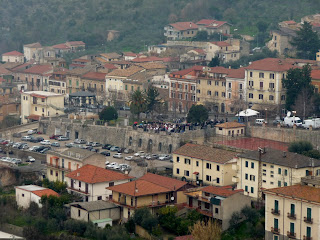 |
| An aerial view of Roccasecca, the town of D'Aquino's birth in the Frosinone province in Lazio |
Roccasecca, D’Aquino’s birthplace, is a town in the province of Frosinone in the Lazio region of central Italy. It is within an area known as Ciociaria by Italians, a name derived from the word ciocie, the footwear worn by the inhabitants in years gone by. Ciociaria hosts food fairs, events and music festivals as well as celebrating traditional feasts, when the local people wear the regional costume and the typical footwear, ciocie.
Hotels in Roccasecca by Booking.com
Travel tip:
The Abbey of Fossanova, where D’Aquino died, is a Cistercian monastery near the railway station of Priverno, about 100 kilometres south-east of Rome. The Abbey dates from around 1135 and is one of the finest example or early Gothic architecture in Italy. Priverno’s patron saint is Saint Thomas Aquinas.
More reading:
Monte Cassino Abbey destroyed by Allies in the Second World War
How bravery of Clare of Assissi was recognised after her death
When the funeral of a nurse brought the city of Rome to a standstill
Also on this day:









